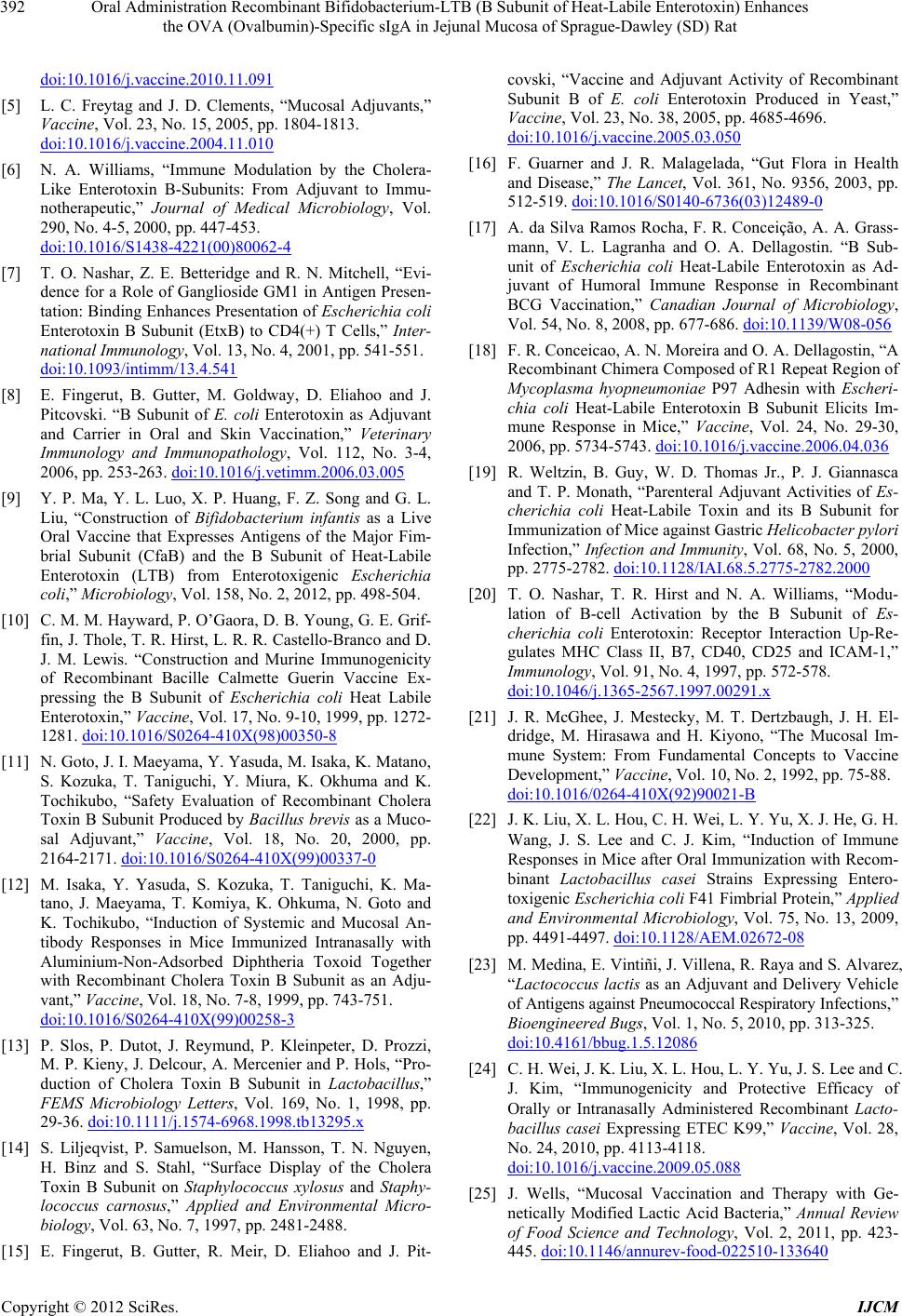
Oral Administration Recombinant Bifidobacterium-LTB (B Subunit of Heat-Labile Enterotoxin) Enhances
the OVA (Ovalbumin)-Specific sIgA in Jejunal Mucosa of Sprague-Dawley (SD) Rat
392
doi:10.1016/j.vaccine.2010.11.091
[5] L. C. Freytag and J. D. Clements, “Mucosal Adjuvants,”
Vaccine, Vol. 23, No. 15, 2005, pp. 1804-1813.
doi:10.1016/j.vaccine.2004.11.010
[6] N. A. Williams, “Immune Modulation by the Cholera-
Like Enterotoxin B-Subunits: From Adjuvant to Immu-
notherapeutic,” Journal of Medical Microbiology, Vol.
290, No. 4-5, 2000, pp. 447-453.
doi:10.1016/S1438-4221(00)80062-4
[7] T. O. Nashar, Z. E. Betteridge and R. N. Mitchell, “Evi-
dence for a Role of Ganglioside GM1 in Antigen Presen-
tation: Binding Enhances Presentation of Escherichia coli
Enterotoxin B Subunit (EtxB) to CD4(+) T Cells,” Inter-
national Immunology, Vol. 13, No. 4, 2001, pp. 541-551.
doi:10.1093/intimm/13.4.541
[8] E. Fingerut, B. Gutter, M. Goldway, D. Eliahoo and J.
Pitcovski. “B Subunit of E. coli Enterotoxin as Adjuvant
and Carrier in Oral and Skin Vaccination,” Veterinary
Immunology and Immunopathology, Vol. 112, No. 3-4,
2006, pp. 253-263. doi:10.1016/j.vetimm.2006.03.005
[9] Y. P. Ma, Y. L. Luo, X. P. Huang, F. Z. Song and G. L.
Liu, “Construction of Bifidobacterium infantis as a Live
Oral Vaccine that Expresses Antigens of the Major Fim-
brial Subunit (CfaB) and the B Subunit of Heat-Labile
Enterotoxin (LTB) from Enterotoxigenic Escherichia
coli,” Microbiology, Vol. 158, No. 2, 2012, pp. 498-504.
[10] C. M. M. Hayward, P. O’Gaora, D. B. Young, G. E. Grif-
fin, J. Thole, T. R. Hirst, L. R. R. Castello-Branco and D.
J. M. Lewis. “Construction and Murine Immunogenicity
of Recombinant Bacille Calmette Guerin Vaccine Ex-
pressing the B Subunit of Escherichia coli Heat Labile
Enterotoxin,” Vaccine, Vol. 17, No. 9-10, 1999, pp. 1272-
1281. doi:10.1016/S0264-410X(98)00350-8
[11] N. Goto, J. I. Maeyama, Y. Yasuda, M. Isaka, K. Matano,
S. Kozuka, T. Taniguchi, Y. Miura, K. Okhuma and K.
Tochikubo, “Safety Evaluation of Recombinant Cholera
Toxin B Subunit Produced by Bacillus brevis as a Muco-
sal Adjuvant,” Vaccine, Vol. 18, No. 20, 2000, pp.
2164-2171. doi:10.1016/S0264-410X(99)00337-0
[12] M. Isaka, Y. Yasuda, S. Kozuka, T. Taniguchi, K. Ma-
tano, J. Maeyama, T. Komiya, K. Ohkuma, N. Goto and
K. Tochikubo, “Induction of Systemic and Mucosal An-
tibody Responses in Mice Immunized Intranasally with
Aluminium-Non-Adsorbed Diphtheria Toxoid Together
with Recombinant Cholera Toxin B Subunit as an Adju-
vant,” Vaccine, Vol. 18, No. 7-8, 1999, pp. 743-751.
doi:10.1016/S0264-410X(99)00258-3
[13] P. Slos, P. Dutot, J. Reymund, P. Kleinpeter, D. Prozzi,
M. P. Kieny, J. Delcour, A. Mercenier and P. Hols, “Pro-
duction of Cholera Toxin B Subunit in Lactobacillus,”
FEMS Microbiology Letters, Vol. 169, No. 1, 1998, pp.
29-36. doi:10.1111/j.1574-6968.1998.tb13295.x
[14] S. Liljeqvist, P. Samuelson, M. Hansson, T. N. Nguyen,
H. Binz and S. Stahl, “Surface Display of the Cholera
Toxin B Subunit on Staphylococcus xylosus and Staphy-
lococcus carnosus,” Applied and Environmental Micro-
biology, Vol. 63, No. 7, 1997, pp. 2481-2488.
[15] E. Fingerut, B. Gutter, R. Meir, D. Eliahoo and J. Pit-
covski, “Vaccine and Adjuvant Activity of Recombinant
Subunit B of E. coli Enterotoxin Produced in Yeast,”
Vaccine, Vol. 23, No. 38, 2005, pp. 4685-4696.
doi:10.1016/j.vaccine.2005.03.050
[16] F. Guarner and J. R. Malagelada, “Gut Flora in Health
and Disease,” The Lancet, Vol. 361, No. 9356, 2003, pp.
512-519. doi:10.1016/S0140-6736(03)12489-0
[17] A. da Silva Ramos Rocha, F. R. Conceição, A. A. Grass-
mann, V. L. Lagranha and O. A. Dellagostin. “B Sub-
unit of Escherichia coli Heat-Labile Enterotoxin as Ad-
juvant of Humoral Immune Response in Recombinant
BCG Vaccination,” Canadian Journal of Microbiology,
Vol. 54, No. 8, 2008, pp. 677-686. doi:10.1139/W08-056
[18] F. R. Conceicao, A. N. Moreira and O. A. Dellagostin, “A
Recombinant Chimera Composed of R1 Repeat Region of
Mycoplasma hyopneumoniae P97 Adhesin with Escheri-
chia coli Heat-Labile Enterotoxin B Subunit Elicits Im-
mune Response in Mice,” Vaccine, Vol. 24, No. 29-30,
2006, pp. 5734-5743. doi:10.1016/j.vaccine.2006.04.036
[19] R. Weltzin, B. Guy, W. D. Thomas Jr., P. J. Giannasca
and T. P. Monath, “Parenteral Adjuvant Activities of Es-
cherichia coli Heat-Labile Toxin and its B Subunit for
Immunization of Mice against Gastric Helicobacter pylori
Infection,” Infection and Immunity, Vol. 68, No. 5, 2000,
pp. 2775-2782. doi:10.1128/IAI.68.5.2775-2782.2000
[20] T. O. Nashar, T. R. Hirst and N. A. Williams, “Modu-
lation of B-cell Activation by the B Subunit of Es-
cherichia coli Enterotoxin: Receptor Interaction Up-Re-
gulates MHC Class II, B7, CD40, CD25 and ICAM-1,”
Immunology, Vol. 91, No. 4, 1997, pp. 572-578.
doi:10.1046/j.1365-2567.1997.00291.x
[21] J. R. McGhee, J. Mestecky, M. T. Dertzbaugh, J. H. El-
dridge, M. Hirasawa and H. Kiyono, “The Mucosal Im-
mune System: From Fundamental Concepts to Vaccine
Development,” Vaccine, Vol. 10, No. 2, 1992, pp. 75-88.
doi:10.1016/0264-410X(92)90021-B
[22] J. K. Liu, X. L. Hou, C. H. Wei, L. Y. Yu, X. J. He, G. H.
Wang, J. S. Lee and C. J. Kim, “Induction of Immune
Responses in Mice after Oral Immunization with Recom-
binant Lactobacillus casei Strains Expressing Entero-
toxigenic Escherichia coli F41 Fimbrial Protein,” Applied
and Environmental Microbiology, Vol. 75, No. 13, 2009,
pp. 4491-4497. doi:10.1128/AEM.02672-08
[23] M. Medina, E. Vintiñi, J. Villena, R. Raya and S. Alvarez,
“Lactococcus lactis as an Adjuvant and Delivery Vehicle
of Antigens against Pneumococcal Respiratory Infections,”
Bioengineered Bugs, Vol. 1, No. 5, 2010, pp. 313-325.
doi:10.4161/bbug.1.5.12086
[24] C. H. Wei, J. K. Liu, X. L. Hou, L. Y. Yu, J. S. Lee and C.
J. Kim, “Immunogenicity and Protective Efficacy of
Orally or Intranasally Administered Recombinant Lacto-
bacillus casei Expressing ETEC K99,” Vaccine, Vol. 28,
No. 24, 2010, pp. 4113-4118.
doi:10.1016/j.vaccine.2009.05.088
[25] J. Wells, “Mucosal Vaccination and Therapy with Ge-
netically Modified Lactic Acid Bacteria,” Annual Review
of Food Science and Technology, Vol. 2, 2011, pp. 423-
445. doi:10.1146/annurev-food-022510-133640
Copyright © 2012 SciRes. IJCM